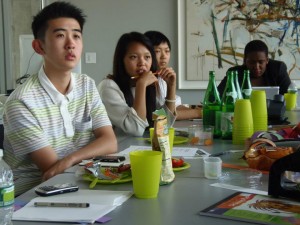 The Museum Teen Summit – a group of youth leaders representing different museums in New York City – is dedicated to improving and promoting the role of youth in museums. At this very first MTS, we brainstormed and compiled our Big Ten List of what makes a successful teen program. This list describes what teens expect from their museum experience, as well as how teens and museum staff members can develop suitable programs. While most the MTS was devoted to art museums, programmers can apply these principles to history museums, too.
The Museum Teen Summit – a group of youth leaders representing different museums in New York City – is dedicated to improving and promoting the role of youth in museums. At this very first MTS, we brainstormed and compiled our Big Ten List of what makes a successful teen program. This list describes what teens expect from their museum experience, as well as how teens and museum staff members can develop suitable programs. While most the MTS was devoted to art museums, programmers can apply these principles to history museums, too.
Big 10 List
- Learn about different career opportunities by meeting with communications, marketing and curatorial staff, for example. High school years are when students explore career opportunities. Museums are packed with professionals from different fields. We can get so much out of programs that let us see what museum careers are like. We can also learn that museums are not all about art; there are conservators, marketers, researchers, administrators, historians and educators, as well.
- Discuss hard-to-understand concepts. We’re here to learn! The key word here is “discuss.” We don’t want to be told what the art means or why it’s interesting. We’re told things all the time in school. Learning should be driven by active engagement. Why choose a hard-to-understand concept? Ideas that aren’t obvious are inherently more intriguing and thought-provoking.
- Let us put our own opinions into our work. It doesn’t matter what the product is or how the result looks. Let us be creative and feel fully engaged. By allowing us to begin projects on our own, or to solve problems with a fresh perspective, we’ll gain a sense of ownership.
- Make art. The George Washington University reports that almost half of all teens are chronically disengaged in school. This isn’t surprising. Too much of our learning is passive, not active. In school, we sit in a classroom and listen to our teacher talk. Hands-on activities, such as making art, can help us learn through our own experience instead. Also, it’s more fun!
- Provide opportunities to learn from each other. It’s not always about learning from adults or professionals. Based on our observations, teens are more comfortable when they learn from their peers. Museums should consider this when designing teen programs.
- Trust young people to make decisions. We’re not asking to be treated like grown-ups; we aren’t grown-ups. We’re capable of making decisions, and we’re open to advice and guidance from adults. We merely ask that you acknowledge, respect and trust our judgment.
- Collaborate with artists. Collaboration is a great way for artists and young people to learn from each other. Teens will find a new talent, meet other teens, and have fun. What can be more inspiring than working with real professionals?
- Give young people real projects to work on in the museum. Looking at and learning about projects in museums is cool. Working on projects is cooler. It’s also an effective way of understanding and appreciating the museum professional’s process.
- Create spaces for us to grow. Museums should be more than just places where we learn about art. They should also be places where we develop our own ideas and thoughts through quality teen programs.
- Provide a variety of ways to be involved, such as drop-ins, multiple-weeks, leadership programs, and social programs. As one MTS member said, “Teen programs: they’re not just an after school special.” Museums should avoid programs that only attract certain kinds of teens or programs that take a “one-size-fits-all” approach. Teens come in all forms with all kinds of interests. Museum programs should reflect this diversity. After all, we do represent your future.
We are constantly learning from each other, from museum professionals, and from our collective experience. This list is not permanent. As Museum Teen Summit grows and changes, this list, too, might change.
Members of Museum Teen Summit have presented at the American Alliance of Museums and New York City’s Museum Educators Roundtable In addition, they have created 6 teen events with museums in New York City. Currently, the group represents 16 different museums. For more information about the group, visit www.museumteensummit.org.



